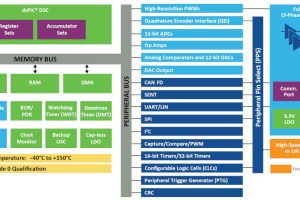
Risc-V offers a choice of is an instruction sets to cover a range of performance levels, then offers extensions to this that are controlled by the Risc-V Foundation, and further offers adopters the chance to add their own instructions – for example to cover specific acceleration hardware.
It is this flexible choice of extensions, plus the stable basic instruction set, that Onno Martens of Trinamic identified as reasons for adopting the architecture.
Within Rocinante, field-oriented control processing in all in hardware accelerators – allowing it to have a fast (possibly 200kHz) control loop to cut over-shoot in motor positioning. ‘Six-point’ motor control ramps are also implemented in hardware.
Because Trinamic is a small company with limited resources, Martens also identified the existence of heavyweight companies within the eco-system supporting Risc-V, and the fast-growth of that eco-system.
Other retails of the chip include USB for in-field service, amplifiers for external current-measuring shunts and drivers for two external full-bridges – eight external mosfets in total.
 For potential customers, there is Dock5, a Development board that uses an FPGA to implement what will be on Rocinante in silicon – a version of which has just taped-out.
For potential customers, there is Dock5, a Development board that uses an FPGA to implement what will be on Rocinante in silicon – a version of which has just taped-out.
 Electronics Weekly Electronics Design & Components Tech News
Electronics Weekly Electronics Design & Components Tech News



